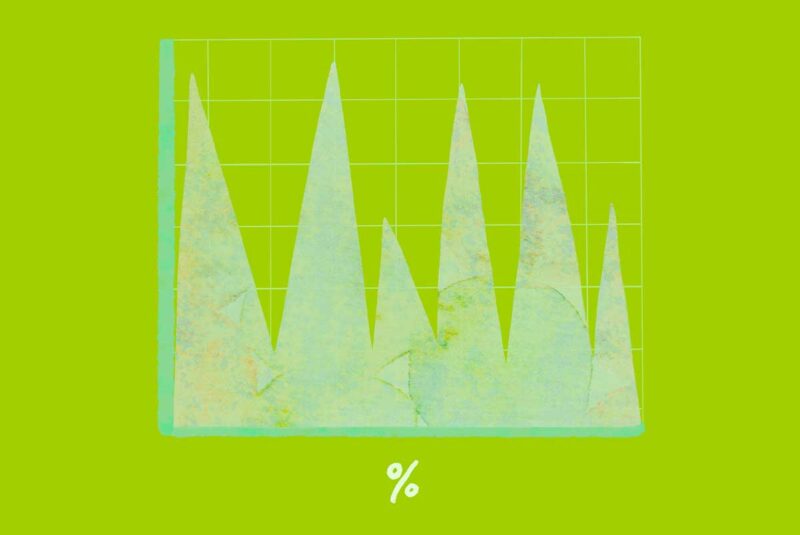There are many numbers involved when it comes to loan terms and savings accounts, like interest rate, annual percentage rate and annual percentage yield. But interest is more than just a number. Knowing if it’s simple interest or compound interest can help you make better financial decisions – whether you’re saving, investing or borrowing.
Compound interest can be a great wealth-building tool if you’re earning it, or it can be a financial stressor if you’re paying it.
So how does compound interest work and how is it calculated? Let’s go over everything you need to know about compound interest.
Compound Interest: Definition
Compound interest is like interest on interest – it’s money earned or paid based on an initial principal balance, plus any interest earned or paid on top of that over time.
The speed at which interest accrues will depend on how often it compounds. The interest rate it accrues at will either be called annual percentage yield (APY) if you earn interest or annual percentage rate (APR) if you pay interest. Understanding APR vs APY doesn’t have to be complicated, but it’s important to know which one you’re dealing with.
The interest is added to your account at the end of each compounding period – which can be daily, monthly, quarterly or yearly. The more compounding periods there are, the more interest you’ll likely earn or pay.
If you’re earning compound interest with a savings or investment account, it can be a tool for growing your money. But it can also be a financial stressor if you’re paying compound interest on a loan or credit card.
Compound interest vs. simple interest
While compound interest is calculated based on a principal amount plus interest accrued during previous periods, simple interest is calculated based solely on a principal balance. And simple interest usually only applies to loans, not savings accounts.
Let’s look at an example. Say you have a loan with monthly payments:
- With compound interest: Part of your monthly payment will be used to pay some of the interest accrued in the previous billing cycle, and the rest of the payment will go toward principal. Since only a portion of the accumulated interest was paid off, the rest is added back on to the loan. Essentially, you pay old and new interest with each monthly payment.
- With simple interest: Part of your monthly payment will be used to pay all of the interest accrued in the previous billing cycle, and the rest of the payment will go toward principal. Interest is never carried over to the next billing cycle. So you’re only paying new interest with each monthly payment.
Compound Interest: How It Works
When interest is added to an account, the balance usually grows. This can be true whether you’re earning interest or making interest payments. So let’s take a look at these two applications of compound interest:
Earning compound interest
When it comes to savings or investment accounts, you can earn money through compound interest, based on the amount of money you deposit, at a rate of return called APY.
For example, if you deposit money into your savings account, the interest you earn will be added on to the principal balance at the end of each compounding period. The more money you add, the more interest you earn.
Paying compound interest
When it comes to loans or credit cards, interest is the cost to borrow from a lender and is paid at a rate called APR. If you refer to our compound interest example above, you can see how compound interest can make paying off your loan take longer. Additional interest is being added to your loan each billing cycle, according to the compounding frequency, even though you’re making payments.
If you only make your minimum payment, you’ll be extending the length of time it takes to pay off your debt and paying more in interest.
While loan payments automatically include interest in each payment, credit card interest works a bit differently. You may not be charged interest on your credit card purchases if you pay your full balance by the statement due date.
Calculating Compound Interest
While the formula for calculating compound interest may look complicated, all you need to do is plug in the right numbers. The compound interest formula is:
A = P ( 1 + [ r / n ] ) n ( t )
A = total amount you end up with
P = initial principal balance
r = annual interest rate (your APR or APY)
n = number of compounding periods per year
t = amount of time (in years) that your money compounds
Compound interest example
Let’s look at an example for a savings account. You put a $1,000 initial deposit into your savings account. The APY is 1% compounded monthly, and you want to see how much you’d have in your account at the end of one year.
A = $1,000 ( 1 + [ .01 / 12 ] ) 12 ( 1 )
A = $1,000 ( 1.0008333…. ) 12
A = $1,000 ( 1.0100459…. )
A = $1,010.05
Using this example, you can see that you would have approximately $1,010 in your savings account after one year, which means you earned $10.05 in interest over the course of the first year.
Again, compound interest is calculated based on the principal plus previous interest earned. So if you want to see how much you’d earn the second year, you’d replace P in the example with your new account balance at the end of year one: $1,010.
Going through the calculations, you can see that A at the end of year two equals $1,020.20, meaning you earned $10.15 in interest during year two. Due to the power of compounding, it’s 10 cents more than the interest earned in year one. It may seem like a small increase, but the interest adds up over time.
Rule Of 72
You can do a quick estimate of how many years it may take you to double your original principal using the rule of 72: take 72 and divide it by your APY.
If your APY is 4%, it will take you approximately 18 years ( 72 / 4 = 18 ) to double whatever your original principal is.
The number of years it will take to double your initial amount will decrease the more money you add to your account. So you’ll have to do this calculation often to get an updated estimate.
Side step the calculations on your own, and use our compound interest calculator to see how much you could earn from your initial savings account deposit and any additional deposits.
How to Use Compound Interest to Your Advantage
Compound interest is an effective tool for accumulating wealth when it comes to saving and investing. We’ve put together some tips to help you take full advantage of the power of compound interest:
- Start investing early: Starting to save or invest in your younger years and letting your money grow over time has a great impact on how much compound interest you can earn. Plus, the greater your initial investments are, the more your money will grow.
- Contribute regularly: Because interest is paid out on the principal balance plus interest, continuing to add money to your savings or investment account means there’s a higher balance to compound. Regular contributions can ensure you’re not only earning interest on interest, but earning interest on an increasing principal balance as well.
- Check the frequency of compounding: If you’re comparing savings or investment accounts, take a look at the compounding frequency to figure out which account may help you earn more. Let’s say two savings accounts have the same interest rate but different compounding periods. You’ll earn more in compound interest on the account that compounds daily over the account that compounds yearly. Remember, more frequent compounding periods means more earned in interest.
- Don’t take money out: The compound magic works best if you don’t make withdrawals from your savings account. The more money you add and the longer you leave it in there, the more compound interest you’ll earn.
Let Your Money Work For You
When it comes to saving and investing, compound interest is interest earned on previously earned interest. This is a great way to make the money you deposit or invest work for you. But compound interest can also be paid on a loan or credit card – and that can be money working against you.
While seeking a low interest rate is important, you’ll want to know if it’s compound interest or simple interest before you accept a loan offer. And comparing compounding frequencies for savings or investment accounts can help you make the most of your money.
The Short Version
- Compound interest is like interest on interest – it’s money earned or paid based on an initial principal balance, plus any interest earned or paid on top of that over time
- While the formula for calculating compound interest may look complicated, all you need to do is plug in the right numbers
- While compound interest is calculated based on a principal amount plus interest accrued during previous periods, simple interest is calculated based solely on a principal balance




